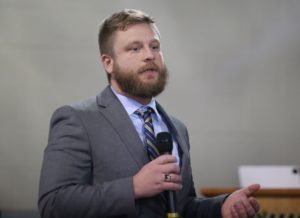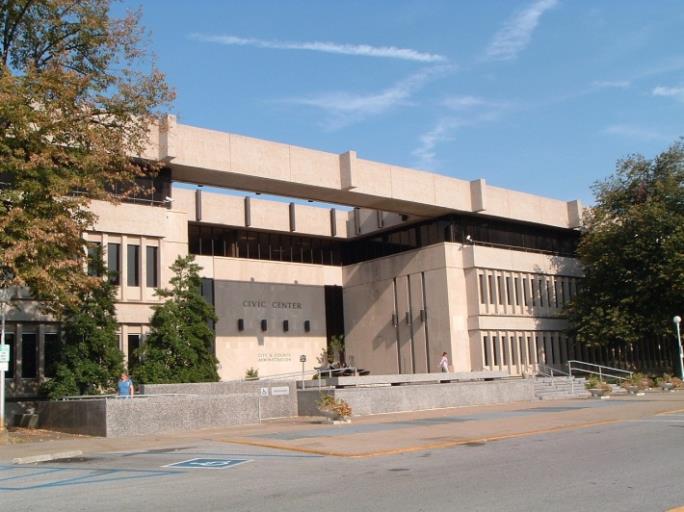|
||||||||||||
 |
||||||||||||
|
||||||||||||
Governor Proposes Returning $1 Billion to Hoosier Taxpayers by Vaneta Becker
Evansville Water And Sewer Utility Opens Bill Relief Program Application To Customers July 1
The Evansville Water and Sewer Utility (EWSU) is launching the Bill Relief Program July 1, 2022, to help income-eligible individuals and families in the community lighten the cost of their utility bill. Customers with a total household income of $50,000 or less may qualify for assistance.
Customers with active city water service who apply for the program and qualify will receive a $3 monthly credit applied to their account each month for one year. The credit offsets the 2022 water rate increase, which will be $2.27 per month effect July 1 (assuming an average monthly water use of 5,000 gallons). After one year, customers may have the opportunity to reapply for the program for an additional 12 months. Dollars not used for the utility bill relief credit will be allocated to provide assistance to income-eligible customer in disconnect status.
Who’s Eligible
Eligibility is based on combined annual household income. EWSU customers with a household income of $50,000 or less may qualify for assistance.
How to Apply
- Visit ewsu.com/BillRelief.
- Fill out the application, including EWSU account number and household income.
- Applicants will receive an email verifying the application was received and whether the request was approved or denied.
Program Funding
Funding for the Bill Relief Program is provided by the American Rescue Plan, which provides direct relief to Americans and the economy during and as a result of the COVID-19 pandemic. The City of Evansville has allocated $4 million in federal funds for up to two years. EWSU is working toward sustaining it as a long-term program, dedicated to offering assistance to individuals and households in greatest need.
Find Out More
To learn more about the Bill Relief Program, visit ewsu.com/ReliefProgram or contact EWSU Customer Service at ewsu.com/contactor by calling 812-436-7846.
Indiana Lifts Water Bill Tax
Also starting in July – unrelated to the EWSU Bill Relief Program – water customers across the state of Indiana will benefit from changes in Indiana utility tax regulations that lift the state tax on water consumption. Beginning July 2022, all EWSU customers will see a decrease in rates and charges on their utility bill. This reduction comes from the amendment to the Public Service Commission Act, submitted by the Indiana Utility Regulatory Commission and passed by the Indiana State Legislature in April 2022. A residential customer who uses an average of 5,000 gallons of water per month will see a $0.46 decrease in their bill each month.
PUBLIC HEALTH COMMISSION TO MEET JUNE 30
|
SENATE CANDIDATE JAMES SCENIAK’S STATEMENT ON THE SUPREME COURT’S DECISION IN “DOBBS v. JACKSON”
My plan on reducing abortions in America:
Supporting adoption: Personally, I have witnessed the great miracle of adoption. Two of my siblings are adopted. As a nation, we need to support adoptive families which includes substantial tax breaks and subsidizing the cost of adoption.
Supporting foster care: This is another blessing that I have been a part of first-hand. In my home, I supported two foster nephews. As a society, we need to support those in the foster system. We need to support the children first, but also support foster families and case workers. I have witnessed the emotional toll on case workers. We as a society need to support those who are working to ensure America’s children are in supportive and loving homes.
Ensuring economic opportunity for all: Abortions have increased numbers in communities that have economic strife. We need to ensure that every individual has the opportunity and freedom to pursue happiness and meaningful life. We do this by ensuring that good economic practices are the standard in Washington, including fighting inflation, waste and reduction of taxes that have become burdensome for American families
Safe sexual practices and contraception options: Ensure we educate young men and woman safe practices within sex. Regular medical checkups, using contraception, giving more options for male and female birth control, and educating about sexually transmitted diseases. We need to increase contraception options for both males and females by removing the government’s over regulatory process within this specific issue.
Our politicians employ emotional issues to divide us so we will, in return, increase the power of the governing body. If you are angry at the injustice of how our government has handled this situation, then good, you want change.
We should direct that anger to a system that has failed both women and preservation of life by using meaningless rhetoric to divide us instead of solutions that bring significant culture change and encourage grace, preservation of life and humanity in our society.
FOOTNOTE: Â POSTED BY THE CITY-COUNTY OBSERVER WITHOUT BIAS OR EDITING.
HOT JOBS
|
|
Crushers come back late, beat Otters in extras
AVON, Ohio -Â Following a 15-minute rain delay late in the game Sunday, the Lake Erie Crushers found a game-tying run to force extra innings and then defeated the Evansville Otters, 3-2.
The game started in a pitcher’s duel, featuring solid outings from Evansville’s Parker Brahms and Lake Erie’s Matt Mulhearn. Brahms finished with another masterful performance with a dozen strikeouts.
It took four innings to find offense Sunday afternoon before the Otters broke the scoreless tie with a sacrifice fly RBI from J.R. Davis.
The 1-0 advantage lasted for Evansville into the seventh when an RBI single from Sean Cheely tied the game at one.
Evansville re-took their lead in the eighth, scoring on another sacrifice fly RBI, this time from Dakota Phillips.
Four pitches into the eighth inning, rain entered the area and forced a brief rain delay. After 15 minutes, the teams returned to the field. After recording two outs, Jacob Bowles had Jackson Valera at a full count before allowing a game-tying solo home run.
Both teams would fail to score in the ninth, forcing extra innings.
In the top half of the tenth, an intentional walk to Steven Sensley set the Otters up for an inning-ending double play.
In the bottom half, a leadoff single put runners at the corners for Lake Erie. Following a foul-out from Kenan Irizarry, Valera was the hero once again with a game-winning RBI single to left field.
The 3-2 Crushers win gave Lake Erie their first series sweep of Evansville since 2012.
With the loss, Evansville dropped to 1-5 on the road trip, 22-16 overall.
Evansville starter Parker Brahms threw another gem, but was left hanging despite a 12-strikeout performance, allowing just one run on five hits across seven complete innings.
The loss went to Logan Sawyer in relief, his first of the year. Sam Curtis grabbed his second win in relief in 2022.
The Evansville Otters return home Tuesday night to kick off a three-game homestand with the Joliet Slammers, with first pitch scheduled for Taco Tuesday at 6:35 p.m.CT, gate open at 5:30 p.m.CT at Bosse Field.
 Letter To Editor: Republicans Should Say Goodbye To Donald Trump
Republicans Should Say Goodbye To Donald Trump
by Dannie McIntire
June 15, 2022
I suspect after my article today there may again be a mob forming resembling the “citizens with touches lit searching for the monster “Frankensteinâ€.
 I’m a conservative, and I’m convinced that it’s time for the Republication Party to say goodbye to Donald Trump.
Yes, I voted for Donald Trump twice, the first time, because I believed in his message, “America Firstâ€; “Make America Great Againâ€; by the time he ran for reelection, I “held my nose†when voting for him, because I thought the alternative offered by the Democrats would be a total disaster for our country. Â
President Trump had many policies that I and many other voters agreed with. However, his distortive view of his self-importance grew increasingly dangerous throughout his term. Donald Trump is a master manipulator, well adept in playing the “us against them†game of politics; keep the populace divided and pitted against one another, and they won’t pay attention to what you’re actually doing or not doing.Â
Throughout Donald Trump’s initial election campaign, the deficits in his personality were clearly there for the voting populace to see, but like the majority of voters in the first election, I voted for “his messageâ€. I truly believe that by the time he ran for reelection, it was his personality “defects†that cost him the election, it wasn’t that the majority were voting for Joe Biden out of their conviction he was the better candidate, they were voting against the “defects†in Trump’s personality. The majority of the voting populace simply did not like him as a person.
Why was this? What were his “defectsâ€?   Â
Let’s first look at the definition of a Narcissist; A self-centered personality style characterized as having an excessive preoccupation with one’s own needs, often at the expense of others.
Second, is the definition of a bully; is “One who is habitually cruel, insulting, or threatening to others who are weaker, smaller, or in some way vulnerableâ€.
Third, the definition of megalomania; is “The belief that oneself is very important about what happens in their environment and that one has the power and the right to change the life of others as one wantsâ€.
Fourth, the definition of a manipulator; is “To control or play upon by artful, unfair, or insidious means, especially to one’s own advantageâ€.Â
Add to the above, from many reliable accounts, Donald Trump as a President was ill-informed on things he should have known or been briefed on. If he was interested, he listened, if he was not interested, he callously waved it off and went on to something that did hold his interest.
When as president, you have to ask your chief of staff if Finland was part of Russia, or if the U.S. could buy Greenland from Denmark, and this man was the “leader of the free worldâ€.
Too many times during his term he fired knowledgeable advisers, and staff members, not because of their job performance, but because he found they weren’t “yes menâ€, he did not want to listen to any advice that did not match his own opinions. That is the classic definition of a “dictatorâ€. Â
Now out of office, his problems continue to grow, from lawsuits to ongoing investigations. We need a president who is truly invested in solving our problems instead of spreading falsehoods in attempting to make his constituents believe he is the new “messiahâ€.Â
Donald Trump lost his reelection campaign, please put away the conspiracy theories, just because your candidate didn’t win, it doesn’t mean it wasn’t a fair election. It Was! That’s the beautiful thing about our democracy we need to celebrate, “we the people†still have the choice when electing our leaders, and when we do make “a mistakeâ€, we rectify it in the next election.Â
This is where I believe my party, the Republican Party, needs to reexamine itself. Its current tilt to the far right is not sustainable in winning future congressional and presidential elections. I fear the Republican Party will eventually splinter into a moderate camp and an extreme right-wing camp that can no longer unite for the good of the party, with potentially one side “picking up their marbles†and storming off to form a new party. With a divided vote, conservatives as a group will suffer.
Of course, I believe the Democratic Party is facing the same above issue, the extreme left against the moderate faction of the party.Â
Perhaps it’s time for a new major political party in our country, one that both moderate republicans and democrats can embrace. How about “The Common Sense Party Of Americaâ€, candidates with personality deficits, lack of common sense, or the inability to compromise, need not apply! Hmmm….is anyone left to run?  Â
FOOTNOTE:  This article was posted by the City-County Observer without bias or editing.  The City-County Observer and their advertisers are not response for the content of this article.
Vanderburgh County Board of Commissioners June 28, 2022 Meeting Agenda
AGENDA  Of The Vanderburgh County Board of Commissioners On June 28, 2022 At 3:00 p.m. Meeting In Room 301, Civic Center ComplexÂ
1. Call to OrderÂ
2. AttendanceÂ
3. Pledge of AllegianceÂ
-
- 4. Action Items A. Health Department 1. COVID-19 UpdateÂ
- 2. IDOH Data Sharing Agreement #64073Â
- 3. IDOH Amendment #2 Contract #44124 Immunization GrantÂ
- 4. Pre to 3 Program Community Health Care Worker Contract: April WestÂ
- 5. Pre to 3 Program Community Health Care Worker Contract: Dalia Carreno CastroÂ
- 6. Credit Card Usage Request: Purchase of TB Validation E-CardsÂ
- B. Engineer 1. Request to Reject All Bids on VC22-06-01 “Resurfacing of Vanderburgh County Roadsâ€Â
- 2. Notice to Bidders for VC22-06-01 “Resurfacing of Vanderburgh County Roadsâ€Â
- 3. Settlement Agreement and General Release: Daylight Properties, LLC Right of Way on the Boonville New Harmony Road ProjectÂ
- 4. United Consulting Supplemental Agreement No. 1: Baseline Road Phase 2Â
- 5. IDEM Stormwater Program Notice of IntentÂ
- 6. Settlement Agreement and General Release: Pinnacle Properties Partners, LLC & Insbrook Development Co. Right of Way on the Green River Road TrailÂ
- C. Treasurer 1. CSG Forte Payments, Inc. Payment Processing AgreementÂ
- D. Computer Services 1. Alpha Laser & Imaging Individual Lease Agreement #1202i: Engineer’s OfficeÂ
- 2. Alpha Laser & Imaging Individual Lease Agreement #1202i: Clerk’s OfficeÂ
- 3. Granicus Service Agreement First AmendmentÂ
- E. Prosecutor’s Office 1. Credit Card Usage Request: Faxage Monthly InvoiceÂ
- 2. Diehl Consulting Group Professional Services/Consulting AgreementÂ
- 3. EVSC Data Sharing Agreement: Peacemaker Grant (8206)Â
- F. Auditor 1. Baker Tilly US, LLP Engagement Letter Agreement Related to ServicesÂ
- G. Courts 1. KS StateBank Financing Agreement for Courtroom Device-Based Digital Recording SystemsÂ
- H. Consideration of Quotes for Demolition of 217 E. Virginia StreetÂ
Drainage Board Immediately FollowingÂ
-
- I. Ordinance No. CO.06-22-006 – An Ordinance Amending Title 17 of the Vanderburgh County Code Concerning Land Use and ZoningÂ
- J. Ordinance No. CO.06-22-010 – An Ordinance Amending Section 17.36.040 of the Vanderburgh County CodeÂ
- A. Approval of June 14th Board of Commissioners Meeting MinutesÂ
- B. Employment ChangesÂ
-
- C. Auditor 1. Claims Voucher Reports i. 06/13-06/17/2022Â
- ii. 06/20-06/24/2022Â
- D. Treasurer 1. May 2022 Monthly ReportÂ
- E. Engineer 1. Report & ClaimsÂ
- F. Highway 1. Department Report 06/10/2022-06/23/2022Â
-
- G. Appropriation Request 1. Commissioners i. Riverboat a. Infrastructure DrainageÂ
- H. Old National Events Plaza Wavier Requests 1. YWCA of Evansville, IN Inc. Women’s Equality Day: 08/25/2022Â
- 2. Treasurer’s Tax Sale: 09/13/2022Â
- I. Substance Abuse Council of Vanderburgh County 1. Local Drug Free Communities Funding ApprovalÂ
-
5. Department Head ReportsÂ
6. New BusinessÂ
7. Old BusinessÂ
8. Consent ItemsÂ
9. Public CommentÂ
10. AdjournmentÂ









